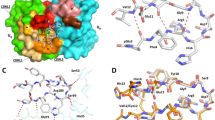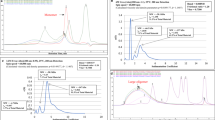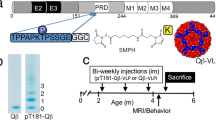Abstract
Recently, we reported that a DNA vaccine, composed of three copies of a self B cell epitope of amyloid-β (Aβ42) and the foreign T-cell epitope, Pan DR epitope (PADRE), generated strong anti-Aβ immune responses in wild-type and amyloid precursor protein transgenic animals. Although DNA vaccines have several advantages over peptide–protein vaccines, they induce lower immune responses in large animals and humans compared with those in mice. The focus of this study was to further enhance anti-Aβ11 immune responses by developing an improved DNA vaccination protocol of the prime–boost regimen, in which the priming step would use DNA and the boosting step would use recombinant protein. Accordingly, we generated DNA and recombinant protein-based epitope vaccines and showed that priming with DNA followed by boosting with a homologous recombinant protein vaccine significantly increases the anti-Aβ antibody responses and do not change the immunoglobulin G1 (IgG1) profile of humoral immune responses. Furthermore, the antibodies generated by this prime–boost regimen were long-lasting and possessed a higher avidity for binding with an Aβ42 peptide. Thus, we showed that a heterologous prime–boost regimen could be an effective protocol for developing a potent Alzheimer's disease (AD) vaccine.
This is a preview of subscription content, access via your institution
Access options
Subscribe to this journal
Receive 12 print issues and online access
$259.00 per year
only $21.58 per issue
Buy this article
- Purchase on Springer Link
- Instant access to full article PDF
Prices may be subject to local taxes which are calculated during checkout






Similar content being viewed by others
References
Ziegler-Graham K, Brookmeyer R, Johnson E, Arrighi HM . Worldwide variation in the doubling time of Alzheimer's disease incidence rates. Alzheimers Dement 2008; 4: 316–323.
Brookmeyer R, Johnson E, Ziegler-Graham K, Arrighi HM . Forecasting the global burden of Alzheimer's disease. Alzheimers Dement 2007; 3: 186–191.
Hardy J, Selkoe DJ . The amyloid hypothesis of Alzheimer's disease: progress and problems on the road to therapeutics. Science 2002; 297: 353–356.
Schenk D . Current challenges for the successful treatment and prevention of Alzheimer's disease: treating the pathologies of the disease to change its clinical course. Alzheimers Dement 2008; 4 (1 Suppl 1): S119–S121.
CNS & Neurological Disorders—Drug Targets. 2009; 8 (1).
CNS & Neurological Disorders—Drug Targets. 2009; 8 (2).
Nicoll JA, Wilkinson D, Holmes C, Steart P, Markham H, Weller RO . Neuropathology of human Alzheimer disease after immunization with amyloid-beta peptide: a case report. Nat Med 2003; 9: 448–452.
Ferrer I, Rovira MB, Guerra MLS, Rey MJ, Costa-Jussa F . Neuropathology and pathogenesis of encephalitis following amyloid-beta immunization in Alzheimer's disease. Brain Pathol 2004; 14: 11–20.
Masliah E, Hansen L, Adame A, Crews L, Bard F, Lee C et al. Abeta vaccination effects on plaque pathology in the absence of encephalitis in Alzheimer disease. Neurology 2005; 64: 129–131.
Holmes C, Boche D, Wilkinson D, Yadegarfar G, Hopkins V, Bayer A et al. Long-term effects of Abeta42 immunisation in Alzheimer's disease: follow-up of a randomised, placebo-controlled phase I trial. Lancet 2008; 372: 216–223.
Gilman S, Koller M, Black RS, Jenkins L, Griffith SG, Fox NC et al. Clinical effects of Abeta immunization (AN1792) in patients with AD in an interrupted trial. Neurology 2005; 64: 1553–1562.
Patton RL, Kalback WM, Esh CL, Kokjohn TA, Van Vickle GD, Luehrs DC et al. Amyloid-beta peptide remnants in AN-1792-immunized Alzheimer's disease patients: a biochemical analysis. Am J Pathol 2006; 169: 1048–1063.
Nicoll JA, Barton E, Boche D, Neal JW, Ferrer I, Thompson P et al. Abeta species removal after abeta42 immunization. J Neuropathol Exp Neurol 2006; 65: 1040–1048.
Petrushina I, Ghochikyan A, Mktrichyan M, Mamikonyan G, Movsesyan N, Davtyan H et al. Alzheimer's disease peptide epitope vaccine reduces insoluble but not soluble/oligomeric A{beta} species in amyloid precursor protein transgenic mice. J Neurosci 2007; 27: 12721–12731.
Movsesyan N, Ghochikyan A, Mkrtichyan M, Petrushina I, Davtyan H, Olkhanud PB et al. Reducing AD-like pathology in 3xTg-AD mouse model by DNA epitope vaccine- a novel immunotherapeutic strategy. PLos ONE 2008; 3: e21–e24.
Hock C, Konietzko U, Streffer JR, Tracy J, Signorell A, Muller-Tillmanns B et al. Antibodies against beta-amyloid slow cognitive decline in Alzheimer's disease. Neuron 2003; 38: 547–554.
Monsonego A, Imitola J, Zota V, Oida T, Weiner HL . Microglia-mediated nitric oxide cytotoxicity of T cells following amyloid beta-peptide presentation to Th1 cells. J Immunol 2003; 171: 2216–2224.
Town T, Tan J, Flavell RA, Mullan M . T-cells in Alzheimer's disease. Neuromolecular Med 2005; 7: 255–264.
Britschgi M, Olin CE, Johns HT, Takeda-Uchimura Y, LeMieux MC, Rufibach K et al. Neuroprotective natural antibodies to assemblies of amyloidogenic peptides decrease with normal aging and advancing Alzheimer's disease. Proc Natl Acad Sci USA 2009; 106: 12145–12150.
Lee M, Bard F, Johnson-Wood K, Lee C, Hu K, Griffith SG et al. Abeta42 immunization in Alzheimer's disease generates Abeta N-terminal antibodies. Ann Neurol 2005; 58: 430–435.
Cribbs DH, Ghochikyan A, Tran M, Vasilevko V, Petrushina I, Sadzikava N et al. Adjuvant-dependent modulation of Th1 and Th2 responses to immunization with beta-amyloid. Int Immunol 2003; 15: 505–514.
Bard F, Barbour R, Cannon C, Carretto R, Fox M, Games D et al. Epitope and isotype specificities of antibodies to beta-amyloid peptide for protection against Alzheimer's disease-like neuropathology. Proc Natl Acad Sci USA 2003; 100: 2023–2028.
McLaurin J, Cecal R, Kierstead ME, Tian X, Phinney AL, Manea M et al. Therapeutically effective antibodies against amyloid-beta peptide target amyloid-beta residues 4–10 and inhibit cytotoxicity and fibrillogenesis. Nat Med 2002; 8: 1263–1269.
Town T, Tan J, Sansone N, Obregon D, Klein T, Mullan M . Characterization of murine immunoglobulin G antibodies against human amyloid-b 1-42. Neurosci Lett 2001; 307: 101–104.
Dickey CA, Morgan DG, Kudchodkar S, Weiner DB, Bai Y, Cao C et al. Duration and specificity of humoral immune responses in mice vaccinated with the Alzheimer's disease-associated beta-amyloid 1-42 peptide. DNA Cell Biol 2001; 20: 723–729.
Lemere CA, Maron R, Selkoe DJ, Weiner HL . Nasal vaccination with beta-amyloid peptide for the treatment of Alzheimer's disease. DNA Cell Biol 2001; 20: 705–711.
Lemere CA, Maron R, Spooner ET, Grenfell TJ, Mori C, Desai R et al. Nasal Aβ treatment induces anti-Aβ antibody production and decreases cerebral amyloid burden in PD-APP mice. Ann NY Acad Sci 2000; 920: 328–331.
Monsonego A, Zota V, Karni A, Krieger JI, Bar-Or A, Bitan G et al. Increased T cell reactivity to amyloid beta protein in older humans and patients with Alzheimer disease. J Clin Invest 2003; 112: 415–422.
Sigurdsson EM, Knudsen E, Asuni A, Fitzer-Attas C, Sage D, Quartermain D et al. An attenuated immune response is sufficient to enhance cognition in an Alzheimer's disease mouse model immunized with amyloid-beta derivatives. J Neurosci 2004; 24: 6277–6282.
Singh H, Raghava GP . ProPred: prediction of HLA-DR binding sites. Bioinformatics 2001; 17: 1236–1237.
Singh H, Raghava GP . ProPred1: prediction of promiscuous MHC class-I binding sites. Bioinformatics 2003; 19: 1009–1014.
Das P, Chapoval S, Howard V, David CS, Golde TE . Immune responses against Abeta1-42 in HLA class II transgenic mice: implications for Abeta1-42 immune-mediated therapies. Neurobiol Aging 2003; 24: 969–976.
Mamikonyan G, Necula M, Mkrtichyan M, Ghochikyan A, Petrushina I, Movsesyan N et al. Anti-Abeta 1-11 antibody binds to different beta-amyloid species, inhibits fibril formation, and disaggregates preformed fibrils, but not the most toxic oligomers. J Biol Chem 2007; 282: 22376–22386.
Agadjanyan MG, Ghochikyan A, Petrushina I, Vasilevko V, Movsesyan N, Mkrtichyan M et al. Prototype Alzheimer's disease vaccine using the immunodominant B cell epitope from beta-amyloid and promiscuous T cell epitope pan HLA DR-binding peptide. J Immunol 2005; 174: 1580–1586.
Ghochikyan A . Rationale for peptide and DNA based epitope vaccines for Alzheimer's disease immunotherapy. CNS Neurol Disord Drug Targets 2009; 8: 128–143.
Ugen KE, Kutzler MA, Marrero B, Westover J, Coppola D, Weiner DB et al. Regression of subcutaneous B16 melanoma tumors after intratumoral delivery of an IL-15-expressing plasmid followed by in vivo electroporation. Cancer Gene Ther 2006; 13: 969–974.
Abdulhaqq SA, Weiner DB . DNA vaccines: developing new strategies to enhance immune responses. Immunol Res 2008; 42: 219–232.
Agadjanyan MG, Wang B, Nyland SB, Weiner DB, Ugen KE . DNA plasmid based vaccination against the oncogenic human T cell leukemia virus type 1. Curr Top Microbiol Immunol 1998; 226: 175–192.
Kim JJ, Nottingham LK, Wilson DM, Bagarazzi ML, Tsai A, Morrison LD et al. Engineering DNA vaccines via co-delivery of co-stimulatory molecule genes. Vaccine 1998; 16: 1828–1835.
Ghochikyan A, Vasilevko V, Petrushina I, Tran M, Sadzikava N, Babikyan D et al. Generation and characterization of the humoral immune response to DNA immunization with a chimeric b-amyloid-interleukin-4 minigene. Eur J Immunol 2003; 33: 3232–3241.
Roy MJ, Wu MS, Barr LJ, Fuller JT, Tussey LG, Speller S et al. Induction of antigen-specific CD8+ T cells, T helper cells, and protective levels of antibody in humans by particle-mediated administration of a hepatitis B virus DNA vaccine. Vaccine 2000; 19: 764–778.
Wang R, Doolan DL, Le TP, Hedstrom RC, Coonan KM, Charoenvit Y et al. Induction of antigen-specific cytotoxic T lymphocytes in humans by a malaria DNA vaccine. Science 1998; 282: 476–480.
MacGregor RR, Boyer JD, Ugen KE, Lacy KE, Gluckman SJ, Bagarazzi ML et al. First human trial of a DNA-based vaccine for treatment of human immunodeficiency virus type 1 infection: safety and host response. J Infect Dis 1998; 178: 92–100.
Babiuk LA, Pontarollo R, Babiuk S, Loehr B, van Drunen Littel-van den Hurk S . Induction of immune responses by DNA vaccines in large animals. Vaccine 2003; 21: 649–658.
Gregersen JP . DNA vaccines. Naturwissenschaften 2001; 88: 504–513.
Cribbs DH, Agadjanyan MG . Immunotherapy for Alzheimer's disease: potential problems and possible solutions. Curr Immunol Rev 2005; 1: 139–155.
Richmond JF, Lu S, Santoro JC, Weng J, Hu SL, Montefiori DC et al. Studies of the neutralizing activity and avidity of anti-human immunodeficiency virus type 1 Env antibody elicited by DNA priming and protein boosting. J Virol 1998; 72: 9092–9100.
Barnett SW, Rajasekar S, Legg H, Doe B, Fuller DH, Haynes JR et al. Vaccination with HIV-1 gp120 DNA induces immune responses that are boosted by a recombinant gp120 protein subunit. Vaccine 1997; 15: 869–873.
Pal R, Kalyanaraman VS, Nair BC, Whitney S, Keen T, Hocker L et al. Immunization of rhesus macaques with a polyvalent DNA prime/protein boost human immunodeficiency virus type 1 vaccine elicits protective antibody response against simian human immunodeficiency virus of R5 phenotype. Virology 2006; 348: 341–353.
Wang S, Kennedy JS, West K, Montefiori DC, Coley S, Lawrence J et al. Cross-subtype antibody and cellular immune responses induced by a polyvalent DNA prime-protein boost HIV-1 vaccine in healthy human volunteers. Vaccine 2008; 26: 3947–3957.
Wang QM, Sun SH, Hu ZL, Yin M, Xiao CJ, Zhang JC . Improved immunogenicity of a tuberculosis DNA vaccine encoding ESAT6 by DNA priming and protein boosting. Vaccine 2004; 22: 3622–3627.
Xiao-wen H, Shu-han S, Zhen-lin H, Jun L, Lei J, Feng-juan Z et al. Augmented humoral and cellular immune responses of a hepatitis B DNA vaccine encoding HBsAg by protein boosting. Vaccine 2005; 23: 1649–1656.
Petrushina I, Ghochikyan A, Mkrtichyan M, Mamikonyan G, Movsesyan N, Ajdari R et al. Mannan-Abeta28 conjugate prevents Abeta-plaque deposition, but increases microhemorrhages in the brains of vaccinated Tg2576 (APPsw) mice. J Neuroinflammation 2008; 5: 42.
Finkelman FD, Holmes J, Katona IM, Urban JF, Beckmann MP, Park LS et al. Lymphokine control of in vivo immunoglobulin isotype selection. Ann Rev Immunol 1990; 8: 303–333.
Snapper CM, Paul WE . Interferon-gamma and B cell stimulatory factor-1 reciprocally regulate Ig isotype production. Science 1987; 236: 944–947.
Hasbold J, Hong JS, Kehry MR, Hodgkin PD . Integrating signals from IFN-gamma and IL-4 by B cells: positive and negative effects on CD40 ligand-induced proliferation, survival, and division-linked isotype switching to IgG1, IgE, and IgG2a. J Immunol 1999; 163: 4175–4181.
Higashi T, Wakui M, Nakano K, Hashimoto K, Takagi R, Tanaka Y et al. Evaluation of adjuvant activities using human antigen presenting cells in vitro. Allergol Int 2008; 57: 219–222.
McAleer JP, Vella AT . Understanding how lipopolysaccharide impacts CD4 T-cell immunity. Crit Rev Immunol 2008; 28: 281–299.
Bayer AJ, Bullock R, Jones RW, Wilkinson D, Paterson KR, Jenkins L et al. Evaluation of the safety and immunogenicity of synthetic Abeta42 (AN1792) in patients with AD. Neurology 2005; 64: 94–101.
Vellas B, Black R, Thal LJ, Fox NC, Daniels M, McLennan G et al. Long-term follow-up of patients immunized with AN1792: reduced functional decline in antibody responders. Curr Alzheimer Res 2009; 6: 144–151.
Movsesyan N, Mkrtichyan M, Petrushina I, Ross TM, Cribbs DH, Agadjanyan MG et al. DNA epitope vaccine containing complement component C3d enhances anti-amyloid-beta antibody production and polarizes the immune response towards a Th2 phenotype. J Neuroimmunol 2008; 205: 57–63.
Banga AK, Prausnitz MR . Assessing the potential of skin electroporation for the delivery of protein- and gene-based drugs. Trends Biotechnol 1998; 16: 408–412.
Babiuk S, van Drunen Littel-van den Hurk S, Babiuk LA . Delivery of DNA vaccines using electroporation. Methods Mol Med 2006; 127: 73–82.
Rizzuto G, Cappelletti M, Maione D, Savino R, Lazzaro D, Costa P et al. Efficient and regulated erythropoietin production by naked DNA injection and muscle electroporation. Proc Natl Acad Sci USA 1999; 96: 6417–6422.
Widera G, Austin M, Rabussay D, Goldbeck C, Barnett SW, Chen M et al. Increased DNA vaccine delivery and immunogenicity by electroporation in vivo. J Immunol 2000; 164: 4635–4640.
Ghochikyan A, Mkrtichyan M, Loukinov D, Mamikonyan G, Pack SD, Movsesyan N et al. Elicitation of T cell responses to histologically unrelated tumors by immunization with the novel cancer-testis antigen, brother of the regulator of imprinted sites. J Immunol 2007; 178: 566–573.
Mkrtichyan M, Ghochikyan A, Loukinov D, Davtyan H, Ichim TE, Cribbs DH et al. DNA, but not protein vaccine based on mutated BORIS antigen significantly inhibits tumor growth and prolongs the survival of mice. Gene Therapy 2008; 15: 61–64.
Vuola JM, Keating S, Webster DP, Berthoud T, Dunachie S, Gilbert SC et al. Differential immunogenicity of various heterologous prime-boost vaccine regimens using DNA and viral vectors in healthy volunteers. J Immunol 2005; 174: 449–455.
Harari A, Bart PA, Stohr W, Tapia G, Garcia M, Medjitna-Rais E et al. An HIV-1 clade C DNA prime, NYVAC boost vaccine regimen induces reliable, polyfunctional, and long-lasting T cell responses. J Exp Med 2008; 205: 63–77.
Garcia-Hernandez Mde L, Gray A, Hubby B, Kast WM . In vivo effects of vaccination with six-transmembrane epithelial antigen of the prostate: a candidate antigen for treating prostate cancer. Cancer Res 2007; 67: 1344–1351.
Shan L . Combination DNA plus protein HIV vaccines. Springer Semin Immunopathol 2006; 28: 255–265.
Subramanian S, Divya Shree AN . Enhanced Th2 immunity after DNA prime-protein boost immunization with amyloid beta (1-42) plus CpG oligodeoxynucleotides in aged rats. Neurosci Lett 2008; 436: 219–222.
Agadjanyan MG, Cribbs DH . Active and passive Abeta-immunotherapy: preclinical and clinical studies and future directions: part I. CNS Neurol Disord Drug Targets 2009; 8: 1–6.
Cribbs DH, Agadjanyan MG . Active and passive Abeta-immunotherapy: preclinical and clinical studies and future directions: part II. CNS Neurol Disord Drug Targets 2009; 8: 82–87.
Petrushina I, Tran M, Sadzikava N, Ghochikyan A, Vasilevko V, Agadjanyan MG et al. Importance of IgG2c isotype in the immune response to b-amyloid in APP/Tg mice. Neurosci Lett 2003; 338: 5–8.
Ghochikyan A, Mkrtichyan M, Petrushina I, Movsesyan N, Karapetyan A, Cribbs DH et al. Prototype Alzheimer's disease epitope vaccine induced strong Th2-type anti-Abeta antibody response with Alum to Quil A adjuvant switch. Vaccine 2006; 24: 2275–2282.
Agadjanyan MG, Trivedi NN, Kudchodkar S, Bennett M, Levine W, Lin A et al. An HIV type 2 DNA vaccines induces cross-reactive immune responses against HIV type 2 and SIV. AIDS Res Hum Retroviruses 1997; 13: 1561–1572.
Acknowledgements
We thank Charles Bon and Caroline Pearson, Biostudy Solutions LLC for the pharmacokinetic and statistical analyses. We also thank Anna Agadjanyan for help with editing. This work was supported by funding from the National Institutes of Health: AG20241 (DHC and MGA), NS50895 (DHC & MGA), NS057395 (MGA) and from the Alzheimer's Association IIRG0728314 (AG). NM was supported by the National Institute on Aging training Grant AG00096.
Author information
Authors and Affiliations
Corresponding author
Rights and permissions
About this article
Cite this article
Davtyan, H., Mkrtichyan, M., Movsesyan, N. et al. DNA prime–protein boost increased the titer, avidity and persistence of anti-Aβ antibodies in wild-type mice. Gene Ther 17, 261–271 (2010). https://doi.org/10.1038/gt.2009.140
Received:
Revised:
Accepted:
Published:
Issue Date:
DOI: https://doi.org/10.1038/gt.2009.140
Keywords
This article is cited by
-
Testing a MultiTEP-based combination vaccine to reduce Aβ and tau pathology in Tau22/5xFAD bigenic mice
Alzheimer's Research & Therapy (2019)
-
A MultiTEP platform-based epitope vaccine targeting the phosphatase activating domain (PAD) of tau: therapeutic efficacy in PS19 mice
Scientific Reports (2019)
-
Humanized monoclonal antibody armanezumab specific to N-terminus of pathological tau: characterization and therapeutic potency
Molecular Neurodegeneration (2017)
-
Alzheimer’s disease AdvaxCpG- adjuvanted MultiTEP-based dual and single vaccines induce high-titer antibodies against various forms of tau and Aβ pathological molecules
Scientific Reports (2016)
-
Co-immunization with DNA and protein mixture: A safe and efficacious immunotherapeutic strategy for Alzheimer's disease in PDAPP mice
Scientific Reports (2015)



